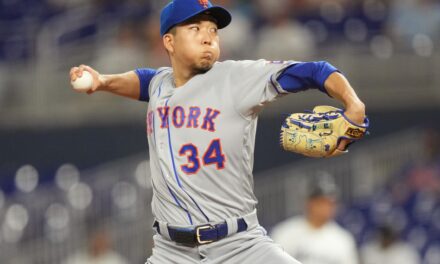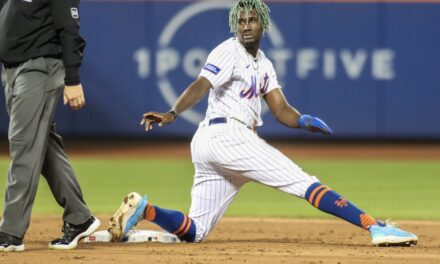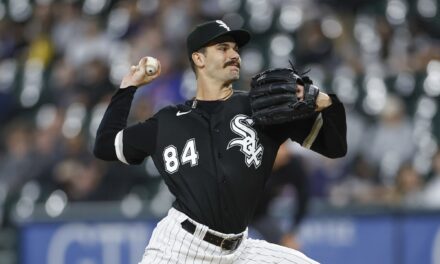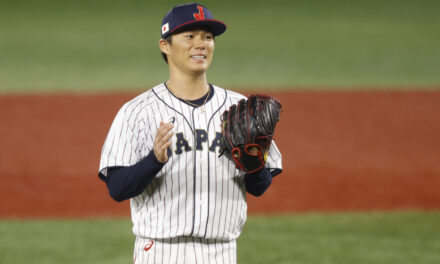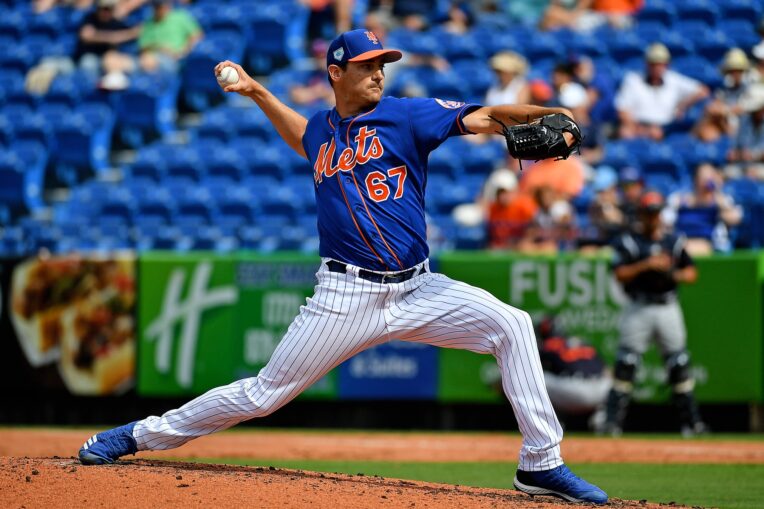
An MMO Fan Shot by Ron Henry.
In the last article I wrote for MMO, I discussed how I thought our new front office was accumulating depth as a way of generating a better offensive and defensive profile using regular platooning in four somewhat standard lineup formations.
While maybe not the big free agent splash some hoped for, I noted that a balanced roster with sufficient depth can provide offense above average, and though it was missed in my last post (sorry!), here is the plate appearance projection of that exercise that would estimate the Mets to have a
top-7 offense or so based on last year’s results:
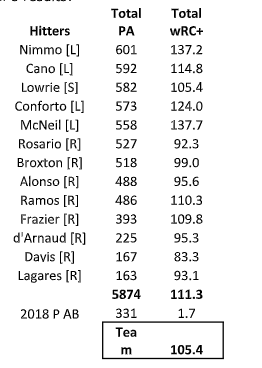
That’s a 10% improvement in team offense over last year’s middle of the pack squad, not including any contributions from Yoenis Cespedes or trade acquisitions, and assuming no major injuries. It’s a good start. This time around, I’d like to turn an analytical focus to the other side of the ball and see where some strategic recommendations from a more statistically driven front office might drive the Mets to a few more wins.
With a revamped bullpen and three bona-fide studs (I’m all-in on Zack Wheeler), there’s definitely an element of plug and play here – just let those guys do their thing and assume the bullpen won’t stick them with nearly as many tough luck losses this year. No – the marginal improvements are likely to come from thinking about the back end of our rotation and what can be done to bridge the gap between our trifecta of right-handed aces. And that’s where the idea of the “Opener” comes in.
For those unfamiliar with the idea of the Opener, the concept is fairly simple and currently en vogue due to some success the Rays and then a few copycat teams had last year. Instead of a traditional starter, bring in a reliever to start a game and get a few outs before giving way to a more traditional non-elite starter, reducing the likelihood that the starter must face the other team’s best hitters (near the top of the lineup) more than twice, when they might be less effective.
Digging deeper, the following are three reasons why I think the Mets would be in an excellent position to consider using an opener for many of Jason Vargas’ starts in 2018.
1. You generally want to use it with a LEFT-HANDED starter whose effectiveness wanes when facing hitters multiple times. Handedness matters here because you want the opener to be opposite- armed to take advantage of a lineup skewed towards one platoon side and also, righty swingmen are much more prevalent.
That leaves us with Steven Matz and Jason Vargas as options. Courtesy of Baseball Reference, here are their career (and 2018) OPS totals given up based on times through the line-up, ignoring a minimal amount of 4th time through the line-up:

Looking at Steven Matz, his profile strikes you as a pitcher not terribly affected by the “third time through the line-up” penalty. If anything, Matz seems to get stronger as the game goes on, and his relative youth means this skill is unlikely to fall off in short order.
Jason Vargas, on the other hand, profiles as an aging starter whose effectiveness dissipates each time a hitter sees him. The issue was exacerbated last year, when he gave up a ridiculous 1.037 OPS when facing a batter for a third time. Due to his age and historical profile, I think the days of a competitive team expecting Vargas to face more than 18 batters is over.
But let’s also not be hasty and write off Vargas as a sunk cost. Look at that last column. Though in their career Matz has been a better pitcher, if you only look at the first and second pass through the lineup, Vargas has actually been 10 points better in OPS. Even in his admittedly terrible 2018, he was only a few points worse than Matz when limited to facing batters only twice.
The data highlights that Vargas can still be a relatively effective innings eater as a fifth starter, as long as he is not expected to go more than four-to-five innings.
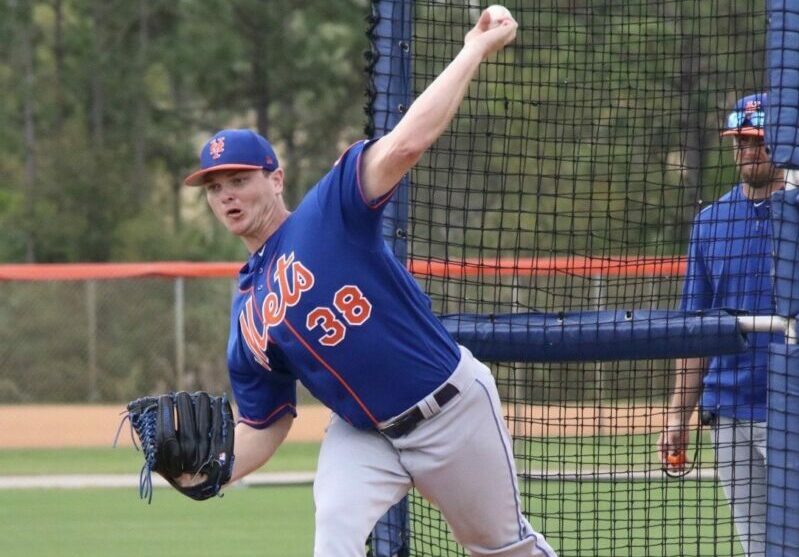
Ed Delany/MMO
2. The Mets retooled their bullpen so that arguably their three best arms to close out games are Edwin Diaz, Jeurys Familia, and Justin Wilson. The two best remaining arms in the pen are Seth Lugo and Robert Gsellman, who both share the same three interesting traits:
- They are right-handed without a firm bullpen role moving forward
- They have almost no platoon split (Lugo .689 v RHB/.673 v LHB; Gsellman .746 v RHB/.744 v
LHB) - They are both converted starters with the ability to pitch multiple innings
Along with a few other interesting names like Kyle Dowdy, the Mets are likely to have 2-3 righty arms at all time to soak up innings in middle relief. Given that we have already established a maximum of roughly 5 innings for Jason Vargas (and often times 4), it is clear that the Mets will often need 2-3 innings of relief just to bridge to the back of the bullpen. KNOWING that those relief innings will be needed, there is an inherent advantage in using them to start the game as opposed to in the middle of the game.
Why? Because of the roster constraints of 25 men and players removed from play after being substituted for, a manager can take advantage of a high run-scoring probability in the 5th/6th innings via a pinch hitter to take a lead or salt away a game. In the first 3 innings, a manager would have to willingly burn a starting player for the chance at one good at-bat – a move almost no manager is willing to make. This means a righty “opener” can often face a righty-heavy lineup without fear of a crucial pinch hitter popping up if he gets into trouble, as is common in the 5th inning and later.
Lastly, because of their lack of platoon splits and ability to go multiple innings, either Lugo or Gsellman would be well-suited to come in and not just pitch the first inning, but potentially go 2 or even 3 innings based on their effectiveness and the output of the Mets offense (see the next point). Because of their similar characteristics, Manager Mickey Callaway has some flexibility on prior days to not feel he has to “reserve” one of these arms as there is a good chance one of them is on enough rest to throw 40-50 pitches if needed at Vargas’ turn in the rotation, so there should be minimal impact to bullpen health. It doesn’t hurt that the next turn in the rotation should typically fall to Jacob deGrom, who typically goes deep into games and provides some bullpen relief.
3. The Mets offense is likely to hurt when Jason Vargas is pitching. What? I’ll repeat that — The Mets offense is likely to hurt when Jason Vargas is pitching. Why? Well, it’s not because Jason Vargas is so spectacularly bad at hitting. In looping back to the ideas about leveraging a defensive line-up that plays to the Mets starter’s strength, it was revealed that the worst “standard” lineup was vs. lefties (no surprise), but especially if there is a flyball pitcher on the mound. Every other Mets starter has a groundball/flyball ratio of 1.39 or better.
Jason Vargas has a career 0.89 GB/FB ratio – in other words, he is an extreme flyball pitcher, and also one that pitches to contact (read: more balls in play – more FLYBALLS in play). That means the Mets may need one or both of Juan Lagares and Keon Broxton out there to adeptly shag deep flies, which is projected to be a bit of a drain on the offensive output (vs. the likes of Conforto, Nimmo, and McNeil).
One final way to goose up the offense when Vargas pitches is by avoiding the first pitcher at-bat in the lineup. The last heretofore untapped potential of the opener strategy is a feature in the National League only, where teams regularly give away 2 of their first 18 at-bats in the form of a pitcher. By relying on an opener like Lugo or Gsellman to go 2 or 3 innings, the Mets could pull them from the game when the pitcher spot is due up in the order and use a pinch hitter in all but the most unlikely run-creating offensive situations (i.e. 2 outs, no RISP) to effectively create a DH on the first pass through the line-up and generate more run support.
Even in situations where the timing does not work well, and Vargas is called into the game in relief in the middle of an inning, the new Mets depth chart is now bursting with versatility. It is not hard to imagine scenarios in which the Mets 8-9-1 or 9-1-2 hitters are due up next when Vargas comes into the game. Such situations will now be ripe for a double switch where guys like Jed Lowrie and Jeff McNeil move around the diamond without giving up much defensively. In a game where there are typically only around 36 at-bats, converting even one from basically a guaranteed out to league average output can make a lot of difference. And as has already been discussed, the Mets have the exact kind of depth and defensive versatility on the bench to support that kind of move.
That’s it in a nutshell. In an ideal world, the Mets have the budget to go get the best starter on the market and plug him into the fifth starter’s role. But in lieu of that, it makes a lot of sense to selectively leverage some “small-market” strategies to squeeze a little more out of the roster.
Additionally, there are some unconfirmed rumors that some of the lower level minor league Mets affiliates have started experimenting with using an opener and that the strategy could begin to translate to the major league squad. Why not here and why not now? While I’m not advocating that the Mets should use the Opener in every game Vargas is slated to pitch, I think it makes a lot of sense when Lugo and Gsellman are well rested and/or the game is either right before or after a day off. I think it’s also a selective tool to use against rival teams where a game up in the standings seems to count twice as much (think: Nationals, Braves, Phillies, Cardinals, Cubs, Brewers).
Over the course of the season, it may only amount to a mathematical difference of 1 or 2 wins. But this year, in this division, it might just be the win or two that gets the Mets into the playoffs. LGM.
* * * * * * * * *
This Fan Shot was contributed by MMO community member and die-hard Mets fan Ron Henry. Have something you want to say about the Mets? Send your article to [email protected] or use this Contact Form. Or ask us about becoming a regular contributor.


